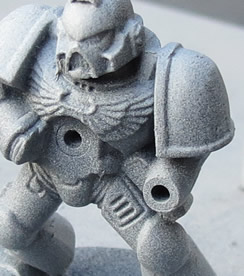 The foundation of painting any miniature successfully is a good coat of primer.
The foundation of painting any miniature successfully is a good coat of primer.In this article I'll discuss some of the finer points of priming and demonstrate them in an easy to follow video.
My brand of choice is Krylon, available at hardware stores or hobby stores like Michaels / Hobby Lobby.
Warnings: Store paints at room temperature. It's also a bad idea to prime if it's too cold, too hot or rainy - in these cases, consider using Gesso. (A paint-on primer.)
Clean The Mold Lines
If you haven't already, read my previous tutorial on Removing Mold Lines. Nothing ruins a beautiful paint job like an ugly mold line. I strongly recommend it even for tabletop quality miniatures because mold lines will stick out like a sore thumb.
Wash your Miniatures
Use some soap and water to clean grease and oils from miniatures before you paint them. They build up as we handle them or use sticky-tack to hold parts of them and will prevent primer to sticking to the model nicely.
I never prime a model until I'm ready to paint it and once it's primed, it's no longer part of my army until I'm done. As you game with primed miniatures, oils will continue to build up and make your paint stick poorly.
Priming Miniatures
The following video explains the process, or you can scroll past it if you'd rather read the details.
Shake Your Paint
Always shake your paint up to make sure it applies well.
If it's taking a while to spray a bunch of stuff, shake it up again later. This prevents the paint from separating and settling in the bottom of the can.
Spraying
Then, start with the can off to the side and begin spraying while moving across the bits. Repeat this over and over, creating many thin layers which slowly build to cover the plastic or metal underneath.
 |
| Learn how to easily build your own Painting Station like I've used here. |
Spray all Sides
Turn the miniatures around and make sure you cover them from all sides.

Cover Evenly
Just keep building up these light layers until you have an even covering of the primer.
(I sometimes move the spray can a little closer as I'm nearly done to add a final, but still not too thick, coat of paint.)
Tip and Spray
Once these first layers have dried, you can safely turn the miniatures and parts over so that you can spray underneath.
If you don't wait until the first layers of paint have dried before tipping your models, the wet paint will dry with ugly flat spots.
Speckling
If your model looks like this, there's a few things that could be wrong.
Usually, this means you're holding your spray can too far away from the miniature. It could also mean that the can is almost empty or it's too cold out to spray.
Touch-Ups
I mentioned Gesso above and it's not just for poor weather. Use it (or white/black paint) to cover the hard to reach spots once you have a good base coat over everything else. This is better than spraying extra paint to try and catch everything as it'll destroy details.
Clean the Nozzle
When you're done, hold the paint can upside down and spray a quick burst. This should use up a little paint, then no more should come out. Once this happens, you shouldn't have to worry about the can's nozzle drying and clogging.
Done!
Remember that from here, you should only handle the mini by the base or from the holding sticks. Natural grease from your fingers will prevent paint from sticking very well. I don't recommend gaming using these models until you've finished painting and have varnished.
[Version 1 of this article can be found here.]








